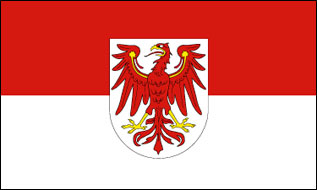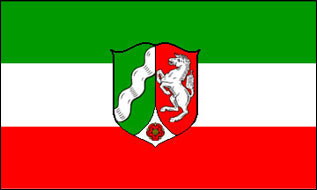The 9 North German Counties
 Berlin: Berlin is capital, city and county in one. Berlin has 3.4 million inhabitants. The area of Berlin is 891.85 km² and is, with 3880 inhabitants per square meter, the most populated city in Germany. Berlin became part of the Federal State of Germany in 1990 after the fall of the wall. Since that time, many things have changed and Berlin is still struggling for an identity. For more info about Berlin read our blog Berlin – A Guide To Berlin 🙂
Berlin: Berlin is capital, city and county in one. Berlin has 3.4 million inhabitants. The area of Berlin is 891.85 km² and is, with 3880 inhabitants per square meter, the most populated city in Germany. Berlin became part of the Federal State of Germany in 1990 after the fall of the wall. Since that time, many things have changed and Berlin is still struggling for an identity. For more info about Berlin read our blog Berlin – A Guide To Berlin 🙂
 Brandenburg: The county Brandenburg has 2.5 million inhabitants and has only 85 inhabitants per square meter. Its vast land with an area of 29,478.61 km² surrounds Berlin and borders Poland in the east. Brandenburg is a quiet county with unspoilt scenery and is shaped by water from the three rivers Oder, Havel and Spree. Most of that scenery is a protected nature reserve. The capital of Brandenburg is Potsdam which is “Germany’s Versailles” with its stunning palace, parks and museums.
Brandenburg: The county Brandenburg has 2.5 million inhabitants and has only 85 inhabitants per square meter. Its vast land with an area of 29,478.61 km² surrounds Berlin and borders Poland in the east. Brandenburg is a quiet county with unspoilt scenery and is shaped by water from the three rivers Oder, Havel and Spree. Most of that scenery is a protected nature reserve. The capital of Brandenburg is Potsdam which is “Germany’s Versailles” with its stunning palace, parks and museums.
 Saxony-Anhalt: Magdeburg is the capital of the county Saxony-Anhalt which has an area of 20,446.31 km². Saxony-Anhalt has 2.3 million inhabitants and lies in the north east of Germany. Saxony-Anhalt is known for its Wörlitz Park, for their fancy Hundertwasser houses in Magdeburg and Wittenberg and for the Reformation of Martin Luther in Wittenberg. Many people get on their bikes and explore the scenery around the Elbe River. Unfortunately Saxony-Anhalt still has a reputation for high unemployment rates and ugly buildings from its GDR time 🙁
Saxony-Anhalt: Magdeburg is the capital of the county Saxony-Anhalt which has an area of 20,446.31 km². Saxony-Anhalt has 2.3 million inhabitants and lies in the north east of Germany. Saxony-Anhalt is known for its Wörlitz Park, for their fancy Hundertwasser houses in Magdeburg and Wittenberg and for the Reformation of Martin Luther in Wittenberg. Many people get on their bikes and explore the scenery around the Elbe River. Unfortunately Saxony-Anhalt still has a reputation for high unemployment rates and ugly buildings from its GDR time 🙁
 North Rhine Westphalia: This is Germany’s highest populated county with a population higher than Austria and Switzerland combined. Nearly 18 million people live in an area of 34,088.01 km². This is 523 people per square meter. This county is well known for its big steel and coal industry which began in the industrial age 100 years ago. Population grew rapidly as there were many jobs to offer in this steel and coal industry. However this growth didn’t last as the demand for steel and coal reduced greatly in the 60’s and many factories were forced to shut down their machines. The top “must sees” in North Rhine Westphalia are Cologne with its stunning dome, the Beethoven town Bonn and the capital Düsseldorf. For more information about Cologne read our blog Köln – A Guide to Cologne. And for more information about Düsseldorf read our Düsseldorf guide.
North Rhine Westphalia: This is Germany’s highest populated county with a population higher than Austria and Switzerland combined. Nearly 18 million people live in an area of 34,088.01 km². This is 523 people per square meter. This county is well known for its big steel and coal industry which began in the industrial age 100 years ago. Population grew rapidly as there were many jobs to offer in this steel and coal industry. However this growth didn’t last as the demand for steel and coal reduced greatly in the 60’s and many factories were forced to shut down their machines. The top “must sees” in North Rhine Westphalia are Cologne with its stunning dome, the Beethoven town Bonn and the capital Düsseldorf. For more information about Cologne read our blog Köln – A Guide to Cologne. And for more information about Düsseldorf read our Düsseldorf guide.
 Lower Saxony: If it comes to physical size, Lower Saxony is the second biggest county after Bavaria. The area is 47,634.90 km². The capital of Lower Saxony is Hanover with about half a million inhabitants. Hanover hosts big communication shows like the CeBit and has quite a few museums to go to. Near Hanover is Wolfsburg. Wolfsburg is home to one of the most successful automobile brands in the world; Volkswagen. Many people living in Wolfsburg also work for VW. Other big cities in Lower Saxony are Celle with its “rat-ridden” Hamelin, Braunschweig and Osnabrück.
Lower Saxony: If it comes to physical size, Lower Saxony is the second biggest county after Bavaria. The area is 47,634.90 km². The capital of Lower Saxony is Hanover with about half a million inhabitants. Hanover hosts big communication shows like the CeBit and has quite a few museums to go to. Near Hanover is Wolfsburg. Wolfsburg is home to one of the most successful automobile brands in the world; Volkswagen. Many people living in Wolfsburg also work for VW. Other big cities in Lower Saxony are Celle with its “rat-ridden” Hamelin, Braunschweig and Osnabrück.
 Bremen: Bremen is the smallest county with an area of just 419.23 km². Bremen has about 660,000 inhabitants and most live in the city of Bremen. Bremerhaven, 65km north of Bremen, is politically linked with Bremen and therefore belongs to Bremen. The county is one of the three Hanseatic cities. Bremerhaven is the sea gateway to the world while Bremen is playing the lead role as a commercial and political centre.
Bremen: Bremen is the smallest county with an area of just 419.23 km². Bremen has about 660,000 inhabitants and most live in the city of Bremen. Bremerhaven, 65km north of Bremen, is politically linked with Bremen and therefore belongs to Bremen. The county is one of the three Hanseatic cities. Bremerhaven is the sea gateway to the world while Bremen is playing the lead role as a commercial and political centre.
 Hamburg: The county of Hamburg has an area or 755km² and the capital is Hamburg. Hamburg is the second biggest city in Germany and has the biggest port. Business is growing fast thanks to the growing economy in Eastern Europe. There is so much more to say about Hamburg, it’s probably the best to read our blog Hamburg – A Guide to Hamburg.
Hamburg: The county of Hamburg has an area or 755km² and the capital is Hamburg. Hamburg is the second biggest city in Germany and has the biggest port. Business is growing fast thanks to the growing economy in Eastern Europe. There is so much more to say about Hamburg, it’s probably the best to read our blog Hamburg – A Guide to Hamburg.
 Schleswig Holstein: The German answer to Cote d’Azur is Schleswig Holstein with its sandy beaches, lighthouses, seals and fjords. It is Germany’s number 1 summer holiday destination and its peninsula looks never ending and is only interrupted by wind farms. Schleswig Holstein’s capital is Kiel with 240,000 inhabitants. The whole state itself has a population of only 2.8 million people. Schleswig Holstein once belonged to the neighbouring country Denmark but since 1864 is part of Germany.
Schleswig Holstein: The German answer to Cote d’Azur is Schleswig Holstein with its sandy beaches, lighthouses, seals and fjords. It is Germany’s number 1 summer holiday destination and its peninsula looks never ending and is only interrupted by wind farms. Schleswig Holstein’s capital is Kiel with 240,000 inhabitants. The whole state itself has a population of only 2.8 million people. Schleswig Holstein once belonged to the neighbouring country Denmark but since 1864 is part of Germany.
 Mecklenburg – Western Pomerania: Last but not least is Mecklenburg – Western Pomerania with its sandy beaches and glittering seas. This is another famous holiday destination among the Germans with three romantic island resorts called Rügen, Usedom and Hiddensee. The state capital is Schwerin with an incredible castle in the heart of the city. The state itself has an area of 23.180,14 km² with a population of 1.6 million.
Mecklenburg – Western Pomerania: Last but not least is Mecklenburg – Western Pomerania with its sandy beaches and glittering seas. This is another famous holiday destination among the Germans with three romantic island resorts called Rügen, Usedom and Hiddensee. The state capital is Schwerin with an incredible castle in the heart of the city. The state itself has an area of 23.180,14 km² with a population of 1.6 million.
